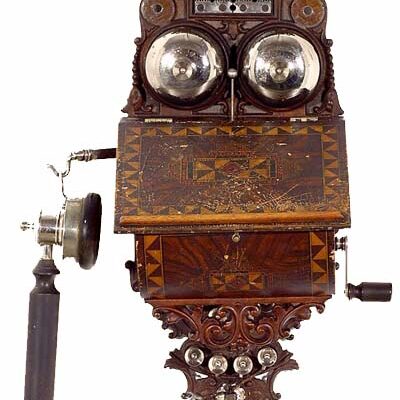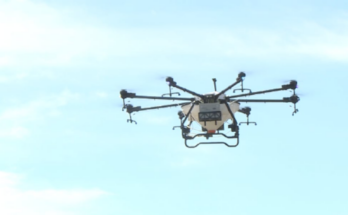History Knox
Mark Sebastian Jordan authors a column each Saturday reflecting on the community’s historic legacy.
MOUNT VERNON — The possibilities that new technology offers are so exciting, it could make you squeak.
But the reality is that technology made for human use is subject to human error.
When I first stumbled across a news article in the July 9, 1885, issue of the Mount Vernon Democratic Banner, I thought I might be witnessing the first case in Mount Vernon history where an exciting piece of brand-new technology — Alexander Graham Bell’s telephone — was going to help catch a criminal.
It didn’t, however, turn out that way.
A little past midnight on July 7, Dr. John E. Russel and his friend H. G. Boynton were walking along East Gambier Street to Russel’s house.

The article doesn’t specify which way they were walking, but when they arrived at Russel’s house, they turned up the front walkway to go to the house. This put them at an angle where they could see up McArthur Street.
Glancing up that way, the doctor thought he saw a man lurking in the shadows around Charles A. Bope’s house, on the corner of McArthur and East Vine Streets.

The doctor drew his friend’s attention to it as he stepped up on his front porch.
Boynton confirmed that it appeared to be a man in a slouch hat wearing a rubber overcoat, which was a sort of rain coat or cape, first popularized during the Civil War, that was waterproofed with vulcanized rubber.
The men decided the fella in the rubber coat looked like a burglar, and there had been other incidents in the neighborhood of house burglaries.
That’s when Dr. Russel had the excellent idea of making use of the new technology installed in his house: The telephone!
The doc was on the cutting edge for 1885, because the modern telephone had only been invented by Alexander Graham Bell nine years earlier. The first telephone exchanges weren’t even set up, and then only on the east coast, until 1879.
One could guess that in 1885, the only telephones in Mount Vernon were probably in a couple of government buildings, and in the homes of a very few wealthy people. One could guess that Dr. Russel’s phone number was somewhere between “1” and “9.”
As it turns out, Mount Vernon city council had only recently decided to expand their emergency system by employing an extra overnight police officer who would monitor the new telephone installed at the Third Ward fire station.

To make this phone work, the recently formed telephone company agreed to employ a nighttime operator to connect any calls that might come through.
The reality, though, is that calls were so few and far between, the night operator tended to either fall asleep or wander off and do other things. And thus the new technology ran headfirst into the classic problem: operator error. Literally.
Dr. Russel went to his newfangled telephone to alert police to the presence of the Bope burglar.
Now, the telephone at this period wasn’t much like the later phones we’ve all encountered.
This is well before the invention of a combined ear and mouthpiece handset. It’s even before the classic early “candlestick” phone.

This was so early in the history of the device that the telephone dial was still in the future.
The way you made a call on this phone, was to pick up the receiver, which was a separate piece, connected with a wire to the body of the phone, which was mounted on a wall, and put the receiver against your ear.
You would grab the crank on the side of the phone and rotate it, which would cause the bell on your phone to ring, as well as the bell at the telephone office to ring.
You would call into the mouthpiece, which was connected directly to the body of the phone, “Hello?” while ringing the bell, until you got an answer.
The operator would then ring the phone you were trying to reach and shout “Hello?” down the line.
When he or she successfully reached someone, he could then plug the first caller’s wire into the call receiver’s line, and the two could talk.
The operator could either listen in, or lean back and take another nap.
Dr. Russel knew that the bell on his phone might alert the burglar to what he was doing, so he used his hand to mute the bell. He called, “Helloooo?” many times into the phone, while cranking away, but received no response from the operator.
He finally gave up in frustration, and he and Boynton ran back outside and ran up McArthur Street to Mr. Bope’s house, in hopes of heading off a crime.

As it turns out, the burglar had been rather clumsy and noisy (and I’ll bet that rubber overcoat squeaked), so his fumbling had awakened Mr. Bope anyway, and Bope had come downstairs to investigate, causing the burglar to take off running.
He disappeared into the night just moments before Russel and Boynton arrived, squeaking into the distance, and was neither caught nor identified.
There was much controversy after the new telephone system failed to operate in the intended manner, because of human error.
And since there can never be headline news without some politician bloviating hot air, the article closed, “[A] prominent member of the fire committee declares that at the next meeting of Council he will bring up the matter and if the trouble can not be remedied, he will offer a resolution to have the telephone taken out of the Third Ward engine house.”
As the southerners say, bless his heart. I’ll bet he squeaked when he walked, too.
Perhaps the best part of this story is that good ol’ Lecky Harper, the witty and mischievous editor of the Banner, saw this as an exquisite opportunity for a clever headline. He titled it “A Hello of a Time.”
Get it? It refers to the doc frustratedly shouting “Hello?” into the telephone without getting an answer, while serving as a double-entendre for the phrase, “a hell of a time,” which Harper could not print in the newspaper in those days, even if such language was commonly enough used in informal settings.
That he was able to make a joke and sneak a rather clear reference to a rude cuss word into a newspaper headline must have made the feisty editor glow with joy. And, I have to say, I find it pretty funny myself.
Anyways, the telephone company and the city eventually got a working system in place, or at least found a way to keep the operator awake at night. And, believe me, as a third-shift worker myself, I feel for that poor operator, who no doubt got into a heap of trouble.
Today it is hard to imagine not having an instant form of communication in emergency situations.
In 1885, this whole arrangement was a new thing, and there was clearly a period of trial and error.
Every system has to start somewhere!
Preferably without squeaks.



